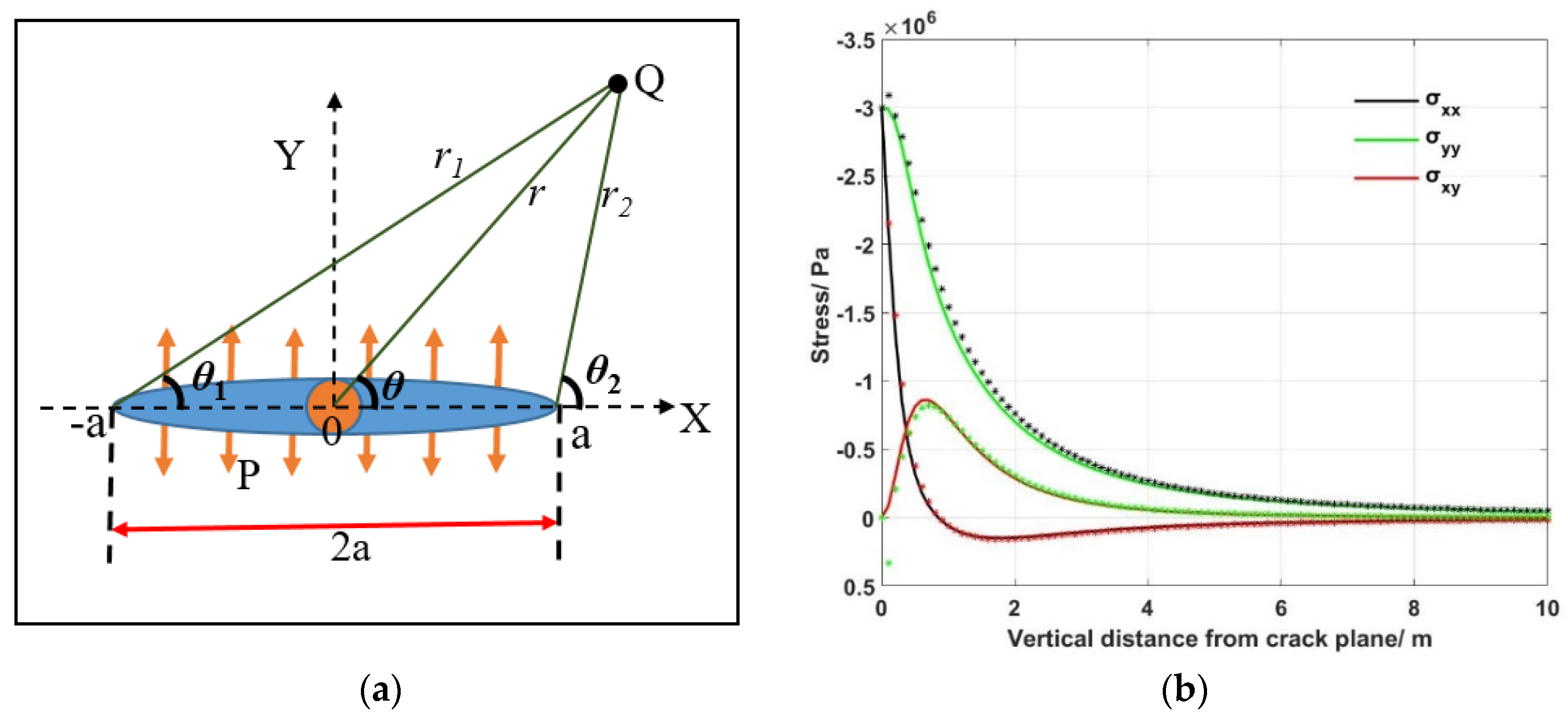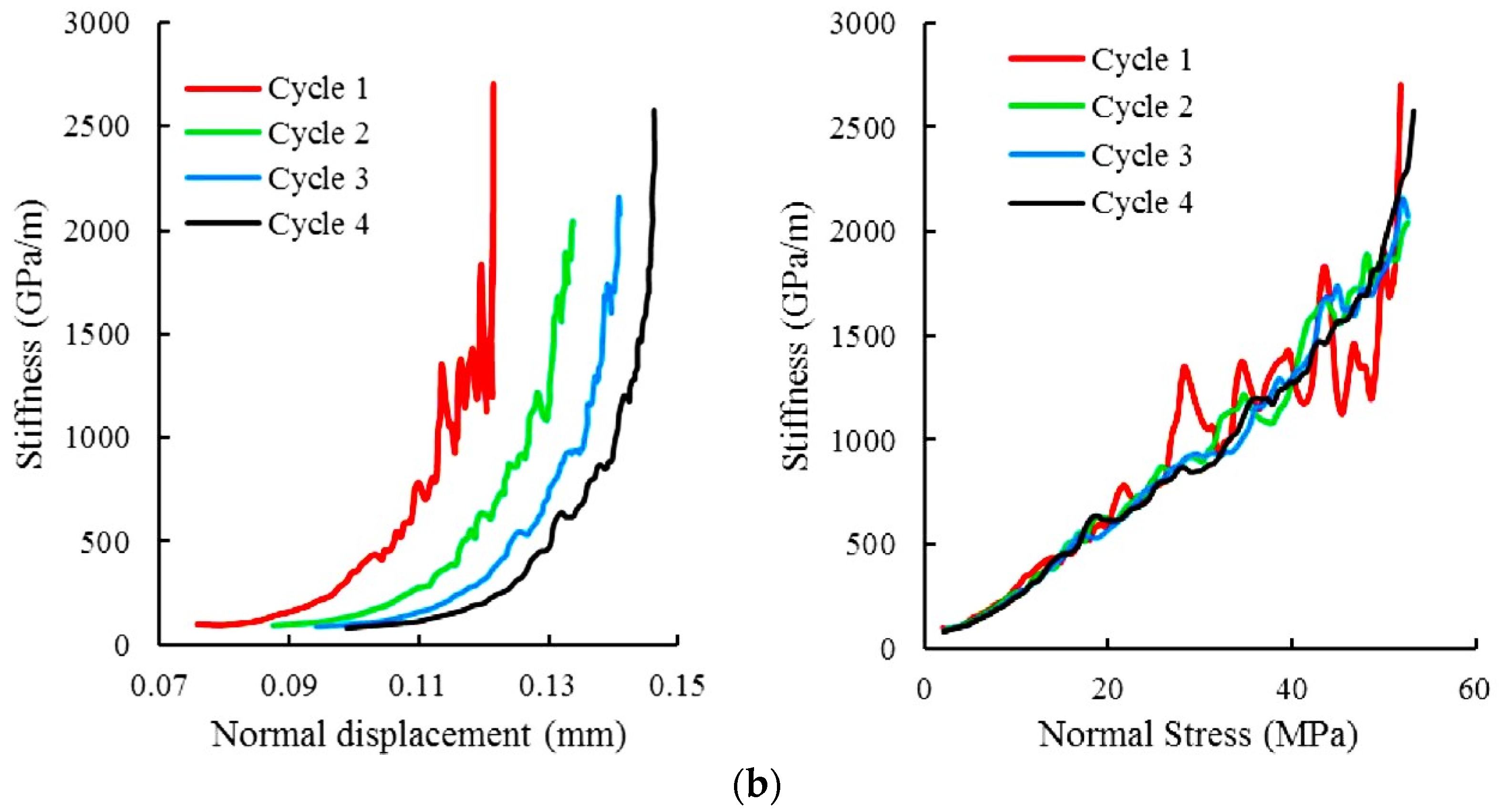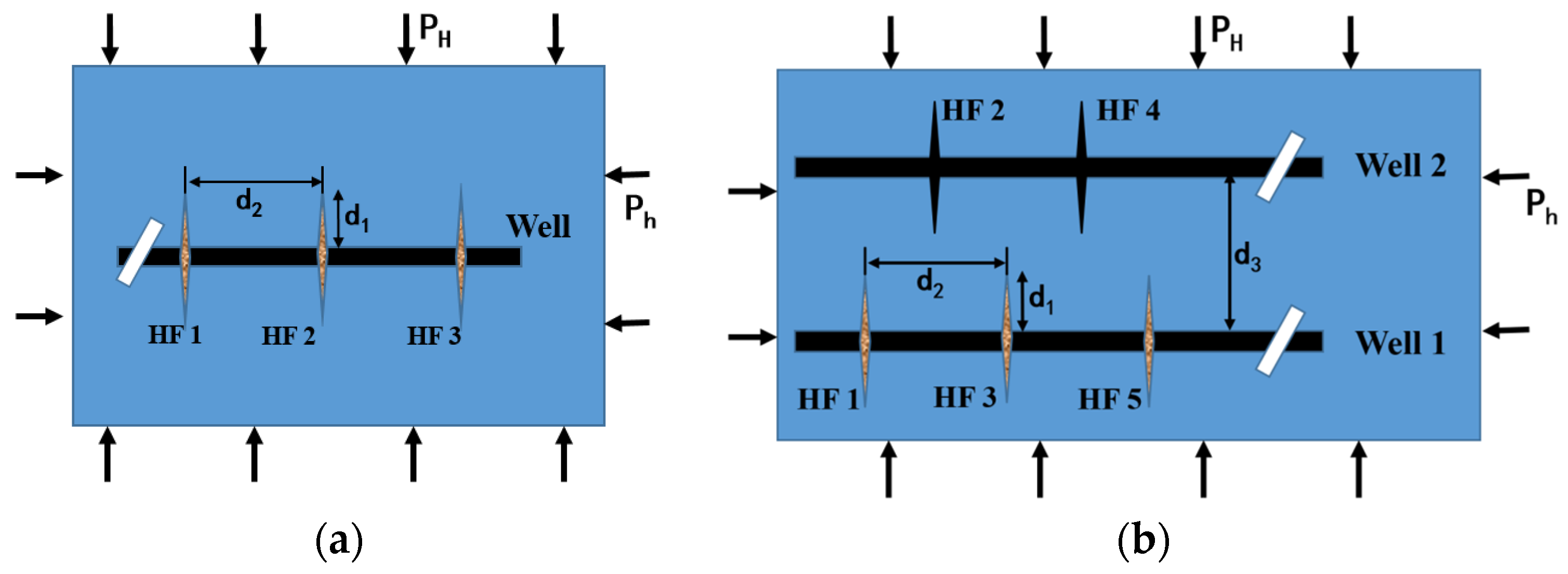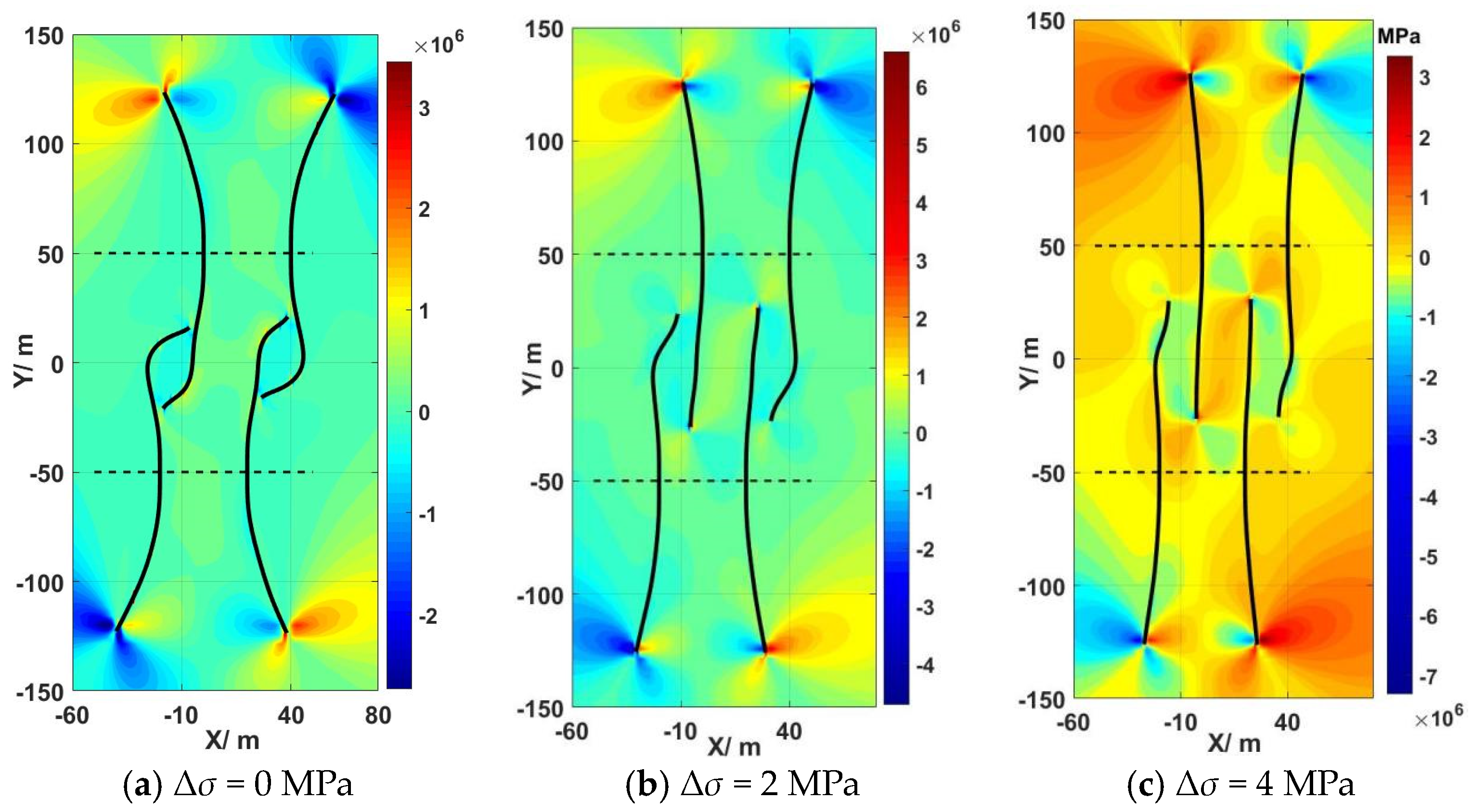Research on the Interaction Mechanism of Multi-Fracture Propagation in Hydraulic Fracturing
Abstract
1. Introduction
2. Numerical Model
2.1. Model Assumption
2.2. Calculation Model of the Supporting Force from the Proppant on the Fracture Surface
2.3. Deformation of Hydraulic Fracture
2.4. The Initiation and Propagation of Fracture
2.5. Numerical Calculation Flow
2.6. Model Validation
3. Results and Discussion
3.1. Space-Time Evolution Mechanism of Induced Stress Field between Fractures
3.2. Mechanism of Fracture Interaction in Synchronous Fracturing
3.3. Study on Fracture Propagation Trajectory of Zipper Fracturing
3.4. Sensitivity Analysis of Fracture Propagation Trajectory
3.5. Discussion
- A stress field calculation model, considering the supporting effect of the proppant, was established. After fracturing, the hydraulic fracture is not completely closed with the support of the proppant but will maintain a certain residual width, affecting the in situ stress field distribution. Previous multi-well fracturing numerical models did not consider the impact of these residual widths on the in situ stress field, resulting in deviations between the simulation results and the actual situation [31,32]. Especially in the case of repeated fracturing or infill well fracturing, the original stress field changes greatly, and previous hydraulic-fracturing calculation models cannot take into account the complex and uneven distribution characteristics of the stress field [33]. This model takes into account the influence of the residual width under proppant support on the stress field and overcomes the shortcomings of previous numerical simulations. It can analyze the stress field distribution in different periods by simulating the historical fracturing process of all the wells on site.
- The spatiotemporal evolution patterns of the induced stress field during the propagation of multiple fractures were analyzed, and based on this, the interaction between the fractures was studied. Previous studies on the stress field during hydraulic-fracturing processes have been limited to specific time points and have not considered the dynamic evolution of the stress field over time, resulting in an incomplete understanding of the fracture interactions during the fracturing process. Especially in reservoirs with multiple wells, multiple fractures, and different construction techniques, it becomes crucial to analyze the fracture interactions from the perspective of the spatiotemporal evolution of the induced stress field.
4. Conclusions
- Based on the boundary element method, a computational model for the propagation of multiple fracture was established using MATLAB programming. The model takes into account the supporting effect of the support agents on crack surfaces, the interaction between multiple cracks, and the dynamic perturbation of the local stress field.
- The induced stress field during the hydraulic-fracturing process exhibits dynamic fluctuation characteristics. In the analysis of the stress field and the interaction between fractures, it is necessary to study the initiation and propagation of fractures by considering the temporal and spatial variation characteristics of the stress field.
- In the process of synchronous fracturing, no matter whether the fractures are arranged head-to-head or staggered between adjacent wells, the fracture tips tend to intersect when they approach each other. The deflection angle of the fracture tip decreases with the increase in the horizontal stress difference.
- It is easy for the zipper fracturing to cause the inter-well fractures to intersect in the process of approaching each other, and the problem of inter-well fracture interference cannot be solved simply by increasing the well spacing. The fracture propagation trajectory can be controlled to some extent by adjusting the fracturing sequence in zipper fracturing.
Author Contributions
Funding
Data Availability Statement
Conflicts of Interest
References
- Petroleum, B. Statistical Review of World Energy; BP: London, UK, 2022. [Google Scholar]
- Khormali, A.; Ahmadi, S. Experimental and modeling analysis on the performance of 2-mercaptobenzimidazole corrosion inhibitor in hydrochloric acid solution during acidizing in the petroleum industry. J. Pet. Explor. Prod. Technol. 2023, 13, 2217–2235. [Google Scholar] [CrossRef]
- Yang, W.M.; Geng, Y.; Zhou, Z.Q.; Li, L.P.; Gao, C.L.; Wang, M.X.; Zhang, D.S. DEM numerical simulation study on fracture propagation of synchronous fracturing in a double fracture rock mass. Geomech. Geophys. Geo Energy Geo Resour. 2020, 6, 2–19. [Google Scholar] [CrossRef]
- Sobhaniaragh, B.; Haddad, M.; Mansur, W.J.; Peters, F.C. Computational modelling of multi-stage hydraulic fractures under stress shadowing and intersecting with pre-existing natural fractures. Acta Mech. 2018, 230, 1037–1059. [Google Scholar] [CrossRef]
- Guo, T.; Wang, X.; Li, Z.; Gong, F.; Lin, Q.; Qu, Z.; Lv, W.; Tian, Q.; Xie, Z. Numerical simulation study on fracture propagation of zipper and synchronous fracturing in hy-drogen energy development. Int. J. Hydrogen Energy 2019, 44, 5270–5285. [Google Scholar] [CrossRef]
- Mayerhofer, M.J.; Stegent, N.A.; Barth, J.O.; Ryan, K.M. Integrating fracture diagnostics and engineering data in the marcellus shale. In Proceedings of the SPE Annual Technical Conference and Exhibition, Denver, CO, USA, 30 October–2 November 2011. [Google Scholar]
- Murillo, G.G.; León, J.M.; Leem, J.; Rojas, C.H.; Salguero, J.; Reyna, J. Successful deployment of unconventional geomechanics to first zipper hydraulic fracturing in low-permeability turbidite reservoir. In Proceedings of the EUROPEC 2015, Madrid, Spain, 1–4 June 2015. [Google Scholar]
- Sierra, L.; Mayerhofer, M. Evaluating the benefits of zipper fracs in unconventional reservoirs. In Proceedings of the SPE Unconventional Resources Conference, Woodlands, TX, USA, 1–3 April 2014. [Google Scholar]
- Ren, X.; Zhou, L.; Li, H.; Lu, Y. A three-dimensional numerical investigation of the propagation path of a two-cluster fracture system in horizontal wells. J. Pet. Sci. Eng. 2019, 173, 1222–1235. [Google Scholar] [CrossRef]
- Zheng, P.; Xia, Y.; Yao, T.; Jiang, X.; Xiao, P.; He, Z.; Zhou, D. Formation mechanisms of hydraulic fracture network based on fracture interaction. Energy 2022, 243, 123057. [Google Scholar] [CrossRef]
- Olson, J.E. Multi-fracture propagation modeling: Applications to hydraulic fracturing in shales and tight gas sands. In Proceedings of the 42nd US Rock Mechanics Symposium (USRMS), San Francisco, CA, USA, 29 June–2 July 2008. [Google Scholar]
- Li, X.; He, Y.; Yang, Z.; Song, R. Prediction and control of hydraulic fracture trajectory in enhanced geothermal system. Energy Sources Part A Recover. Util. Environ. Eff. 2020, 1–23. [Google Scholar] [CrossRef]
- Ju, Y.; Li, Y.; Wang, Y.; Yang, Y. Stress shadow effects and microseismic events during hydrofracturing of multiple vertical wells in tight reservoirs: A three-dimensional numerical model. J. Nat. Gas Sci. Eng. 2020, 84, 103684. [Google Scholar] [CrossRef]
- Cheng, W.; Jiang, G.; Jin, Y. Numerical simulation of fracture path and nonlinear closure for simultaneous and sequential fracturing in a horizontal well. Comput. Geotech. 2017, 88, 242–255. [Google Scholar] [CrossRef]
- Saberhosseini, S.E.; Chen, Z.; Sarmadivaleh, M. Multiple Fracture Growth in Modified Zipper Fracturing. Int. J. Géoméch. 2021, 21, 04021102. [Google Scholar] [CrossRef]
- Shaffner, J.T.; Cheng, A.; Simms, S.; Keyser, E.; Yu, M. The Advantage of Incorporating Microseismic Data into Fracture Models. In Proceedings of the Canadian Unconventional Resources Conference, Calgary, AB, Canada, 15–17 November 2011. [Google Scholar]
- Atkinson, B.K. Fracture Mechanics of Rock; Academic Press: London, UK, 1987. [Google Scholar]
- Nguyen, H.T.; Lee, J.H.; Elraies, K.A. A review of PKN-type modeling of hydraulic fractures. J. Pet. Sci. Eng. 2020, 195, 107607. [Google Scholar] [CrossRef]
- Geertsma, J.; De Klerk, F. A Rapid Method of Predicting Width and Extent of Hydraulically Induced Fractures. J. Pet. Technol. 1969, 21, 1571–1581. [Google Scholar] [CrossRef]
- Kim, J.H.; Paulino, G.H. On Fracture Criteria for Mixed-Mode Crack Propagation in Functionally Graded Materials. Mech. Adv. Mater. Struct. 2007, 14, 227–244. [Google Scholar] [CrossRef]
- Cheng, W.; Jin, Y.; Chen, M. Reactivation mechanism of natural fractures by hydraulic fracturing in naturally fractured shale reservoirs. J. Nat. Gas Sci. Eng. 2015, 23 Pt P3, 431–439. [Google Scholar] [CrossRef]
- Crouch, S.L.; Starfield, A.M.; Rizzo, F.J. Boundary Element Methods in Solid Mechanics. J. Appl. Mech. 1983, 50, 704–705. [Google Scholar] [CrossRef]
- Li, K.; Huang, L.-H.; Huang, X.-C. Propagation simulation and dilatancy analysis of rock joint using displacement discontinuity method. J. Central South Univ. 2014, 21, 1184–1189. [Google Scholar] [CrossRef]
- Olson, J.E. Fracture aperture, length and pattern geometry development under biaxial loading: A numerical study with appli-cations to natural, cross-jointed systems. Geol. Soc. Lond. Spec. Publ. 2007, 289, 123–142. [Google Scholar] [CrossRef]
- Erdogan, F.; Sih, G.C. On The Crack Extension in Plates Under Plane Loading and Transverse Shear. J. Basic Eng. 1963, 85, 519–525. [Google Scholar] [CrossRef]
- Sneddon, I.N.; Elliott, H.A. The opening of a Griffith crack under internal pressure. Q. Appl. Math. 1946, 4, 262–267. [Google Scholar] [CrossRef]
- Zheng, P.; Gu, T.; Liu, E.; Zhao, M.; Zhou, D. Simulation of Fracture Morphology during Sequential Fracturing. Processes 2022, 10, 937. [Google Scholar] [CrossRef]
- Zhou, J.; Zhang, L.; Qi, S.; Yang, D. Empirical ratio of dynamic to static stiffness for propped artificial fractures under variable normal stress. Eng. Geol. 2020, 273, 105683. [Google Scholar] [CrossRef]
- Zheng, P.; Liu, E.; Zhou, D.; Du, X.; Ma, Z. Factors Controlling the Hydraulic Fracture Trajectory in Unconventional Reservoirs. Geofluids 2022, 2022, 8793136. [Google Scholar] [CrossRef]
- Zhang, Y.; Zou, Y.; Zhang, Y.; Wang, L.; Liu, D.; Sun, J.; Ge, H.; Zhou, D. Experimental Study on Characteristics and Mechanisms of Matrix Pressure Transmission Near the Fracture Surface During Post-Fracturing Shut-In in Tight Oil Reservoirs. J. Pet. Sci. Eng. 2022, 219, 111133. [Google Scholar] [CrossRef]
- Cai, X.; Zhao, W.; Hu, T.; Du, X.; Wang, H.; Liu, X. Study on the Interaction Propagation Mechanism of Inter-Cluster Fractures under Different Fracturing Sequences. Processes 2024, 12, 971. [Google Scholar] [CrossRef]
- Zhou, D.; Zheng, P.; Yang, J.; Li, M.; Xia, Y.; Cai, W.; Ma, X.; Liu, S. Optimizing the construction parameters of modified zipper fracs in multiple horizontal wells. J. Nat. Gas Sci. Eng. 2019, 71, 102966. [Google Scholar] [CrossRef]
- Zhang, Q.; Zhang, X.; Sun, W. A review of laboratory studies and theoretical analysis for the interaction mode between in-duced hydraulic fractures and pre-existing fractures. J. Nat. Gas Sci. Eng. 2021, 86, 103719. [Google Scholar] [CrossRef]













| Parameters | Value | Parameters | Value |
|---|---|---|---|
| Young’s modulus (MPa) | 30,000 | Minimum horizontal stress (MPa) | 40 |
| Poisson’s ratio | 0.25 | Fracture toughness (MPa·m1/2) | 2.5 |
| Maximum horizontal stress (MPa) | 40 | Injection pressure (MPa) | 44 |
| Perforating depth (m) | 1 | Fracture spacing (m) | 10 |
Disclaimer/Publisher’s Note: The statements, opinions and data contained in all publications are solely those of the individual author(s) and contributor(s) and not of MDPI and/or the editor(s). MDPI and/or the editor(s) disclaim responsibility for any injury to people or property resulting from any ideas, methods, instructions or products referred to in the content. |
© 2024 by the authors. Licensee MDPI, Basel, Switzerland. This article is an open access article distributed under the terms and conditions of the Creative Commons Attribution (CC BY) license (https://creativecommons.org/licenses/by/4.0/).
Share and Cite
Zhang, L.-P.; Gu, T.; Li, B.; Zheng, P. Research on the Interaction Mechanism of Multi-Fracture Propagation in Hydraulic Fracturing. Processes 2024, 12, 1040. https://doi.org/10.3390/pr12051040
Zhang L-P, Gu T, Li B, Zheng P. Research on the Interaction Mechanism of Multi-Fracture Propagation in Hydraulic Fracturing. Processes. 2024; 12(5):1040. https://doi.org/10.3390/pr12051040
Chicago/Turabian StyleZhang, Lin-Peng, Tuan Gu, Bin Li, and Peng Zheng. 2024. "Research on the Interaction Mechanism of Multi-Fracture Propagation in Hydraulic Fracturing" Processes 12, no. 5: 1040. https://doi.org/10.3390/pr12051040
APA StyleZhang, L.-P., Gu, T., Li, B., & Zheng, P. (2024). Research on the Interaction Mechanism of Multi-Fracture Propagation in Hydraulic Fracturing. Processes, 12(5), 1040. https://doi.org/10.3390/pr12051040






